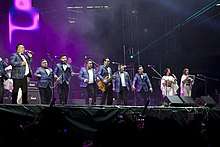Los Ángeles Azules
Los Ángeles Azules are a Mexican musical group playing the cumbia sonidera genre, which is a cumbia subgenre using the accordion and synthesizers. This results in a fusion of the sounds of cumbia from the 1950-1970s with those of 1990s-style electronic music.[1]
Los Ángeles Azules | |
|---|---|
 | |
| Background information | |
| Origin | Mexico City, Mexico |
| Genres | Mexican cumbia Cumbia Sinfónica |
| Years active | 1983–present |
| Website | losangelesazules |
History
The group got together in 1976 but started officially in 1983, playing the onda grupera genre, formed by the siblings of the Mejía Avante family: Elías, Alfredo, José Hilario, Jorge, Cristina and Guadalupe.[1]
The group went through various periods of popularity and various styles. In 1997 they had a huge hit with Cómo Te Voy a Olvidar, re-recorded many hits with guest vocalists including Carla Morrison, Lila Downs, and Ximena Sariñana in 2013. In 2014 they launched a new musical genre cumbia sinfónica as they performed their greatest contemporary hits with the Mexico City Symphony Orchestra. Their subsequent album Cómo Te Voy a Olvidar Edición de Súper Lujo reached #5 on the Mexican regional music charts.[1]
In 2016, they issued De Plaza En Plaza, which features collaborations with mexican artist Gloria Trevi, Yuri, Natalia Lafourcade, spanish Miguel Bosé, american duo Ha*Ash, among others.[2] The first single from the album was "La Cumbia del Infinito" with Natalia Lafourcade and Rodrigo & Gabriela; released on June 3, 2016. The second single "Mi Niña Mujer" with Ha*Ash was released on August 5, 2016.[3] The same year they recorded their twenty-seventh album Esto Sí Es Cumbia.[4]
The album was officially released on june 2018, under the OCESA Seitrack.[5] Esto Sí Es Cumbia is primarily a cumbia, the album consists entirely of cover songs.[5] Included interpretations of "Nunca Es Suficiente" with Natalia Lafourcade, "Me Cuesta Tanto Olvidarte" with Mecano, "Perdón, Perdón" with Ha*Ash, "El Amor Después del Amor" with Fito Paéz, among others.[6] In 2018, they played on the Coachella Stage at the Coachella Valley Music and Arts Festival, making it the first time a traditional cumbia group has played at the popular festival.[7]
Discography
- Bailando Monkey (1964)
- Ritmo... Alegría... Sabor!, Vol. 1 (1982)
- Los Ángeles Azules, Vol. 2 (1983)
- Los Ángeles Azules, Vol. 3 (1984)
- Cumbia de la Tostadita, Vol. 4 (1985)
- Cumbia de las Chispitas, Vol. 5 (1987)
- Los Ángeles Azules, Vol. 6 (1988)
- Y Valió La Pena Esperar, Vol. 7 (1989)
- Y Esta... Si Es Cumbia, Vol. 8 (1991)
- Mis Primeros 15 Exitos de Colección (1997)
- Entrega de Amor (1993)
- Sin Pecado (1995)
- 15 Hits (1995)
- 12 Éxitos Instrumentales (1995)
- Inolvidables (1996)
- 15 Exitos de Colección (1996)
- Dance Mixes (1997)
- Confesiones De Amor (1998)
- Una Lluvia De Rosas (1999)
- Alas Al Mundo (2002)
- En Vivo, Azul Vivo (2002)
- Nunca Te Olvidaré (2004)
- Interpretan Éxitos de Juan Gabriel (2006)
- Tu Juguete (2007)
- A Ritmo De Cumbia (2012)
- Cómo Te Voy a Olvidar (2013)
- Viernes Cultural (2014)
- De Plaza En Plaza (2016)
- Esto Sí Es Cumbia (2018)
References
- Los Ángeles Azules: Artist biography by Drago Bonacich", AllMusic
- "Los Ángeles Azules estrenan de Plaza en Plaza". Tropicalísima 13-50 (in Spanish). Retrieved 2020-08-07.
- "Los Ángeles Azules lanza el tema "Mi niña mujer" Feat. Ha*Ash". Vesper Public Relations. 2016-08-11. Retrieved 2020-08-07.
- @ecra; oreyes (2018-06-05). "Los Ángeles Azules lanzan álbum "Esto sí es cumbia"". Diario de México (in Spanish). Retrieved 2020-08-07.
- Roque, Chilango com-José Quezada (2018-06-04). "Esto sí es cumbia: el nuevo disco de Los Ángeles Azules". Chilango (in Spanish). Retrieved 2020-08-07.
- Diario, El Nuevo. "El Nuevo Diario". El Nuevo Diario (in Spanish). Retrieved 2020-08-07.
- Wood, Mikael. "Azules' cumbia beat: A well-received first for Coachella". LA Times.